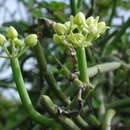tr
kırıntılardaki isimler


Cynanchum viminale is a leafless succulent plant in the family Apocynaceae. The species is native to West Africa, the Indian Ocean and Western Pacific region. The species' natural range extends from South Africa throughout much of Africa and the Middle East to India, Indochina, Southern China, Indomalaya and into Meganesia.[2][3][4] The species is also found on several Indian Oceans islands including Mauritius, Réunion and the Seychelles.
In keeping with its wide distribution, the species is known by a range of common names, including caustic-creeper, caustic bush, sacred soma, soma, rou shan hu,[2] Rapunzel plant, liane calle and kitupa.[3]
Cynanchum viminale is a leafless succulent plant with cylindrical, green photosynthetic stems.[5][6] The plant may grow as a shrub or a scandent vine. The stems produce copious amounts of milky exudate when broken. This exudate is caustic in nature and can cause burns if it contacts human skin. The plant produces small white flowers in clusters. Flowers are followed by long pods which produce numerous seeds with silky plumes that aid in wind dispersal.[5] The environmental range of the species is very broad, extending from rainforest margins and monsoon forests[5] to arid deserts.[3][7]
Toxicity appears to be variable, even locally. The plant is known to cause poisoning and death in livestock.[3][8][9]
The taxonomic status of this species is controversial.
The genus Sarcostemma has been shown to be nested within the genus Cynanchum,[10] and Sarcostemma was put into synonymy with Cynanchum in 2002. Thus, Sarcostemma viminale is correctly known as Cynanchum viminale. However this change has not been accepted by all taxonomists and the name Sarcostemma remains in use by a minority,[3][11] despite later genetic evidence.[10]
The species has numerous subspecies, though precisely how many remains in dispute, and this is further complicated by the difficulty in definitively distinguishing C. viminale from closely related species.[10][12][13]
In Kenya, it is considered quality forage; in Somalia and South Africa the stems are eaten by humans, either raw or cooked.[3]
The plant has been used as a traditional medicine to treat a range of conditions, including sores and wounds, smallpox, eye infections, diarrhoea, intestinal and skin parasites and insufficient milk production.[3][6][14] The aerial parts, roots and latex of the plant are all used for medicine, and the method of use various from ingestion of plant parts, drinking a decoction of the plant, application of the sap to affected parts, exposure to smoke from the burning plant or placing patients onto bedding made from the plant.[3][15] Care is usually required because of the poisonous and caustic nature of the sap, however in some locales toxicity is considered low, at least for part of the year.[3]
{{cite journal}}: CS1 maint: DOI inactive as of December 2022 (link) Cynanchum viminale is a leafless succulent plant in the family Apocynaceae. The species is native to West Africa, the Indian Ocean and Western Pacific region. The species' natural range extends from South Africa throughout much of Africa and the Middle East to India, Indochina, Southern China, Indomalaya and into Meganesia. The species is also found on several Indian Oceans islands including Mauritius, Réunion and the Seychelles.
In keeping with its wide distribution, the species is known by a range of common names, including caustic-creeper, caustic bush, sacred soma, soma, rou shan hu, Rapunzel plant, liane calle and kitupa.
Cynanchum viminale (L.) L.[1] è una pianta succulenta della famiglia delle Asclepiadaceae (o Apocynaceae secondo la classificazione APG[2]).
L'areale di questa specie si estende dall'Africa subsahariana (Eritrea, Etiopia, Somalia, Kenya, Tanzania, Angola, Malawi, Zimbabwe, Namibia, Sudafrica, Madagascar, Capo Verde, Mauritius e Seychelles), attraverso la penisola arabica (Oman, Arabia Saudita e Yemen), l'India e le Filippine, sino all'Oceania (Australia e Nuova Caledonia)[3].
Alcuni autori identificano questa specie con il Soma, la pianta sacra utilizzata a scopo rituale nel Vedismo[4].
url (aiuto). URL consultato il 17 settembre 2014. Cynanchum viminale (L.) L. è una pianta succulenta della famiglia delle Asclepiadaceae (o Apocynaceae secondo la classificazione APG).
Cynanchum viminale là một loài thực vật có hoa trong họ La bố ma. Loài này được (L.) L. mô tả khoa học đầu tiên năm 1771.[1]
Cynanchum viminale là một loài thực vật có hoa trong họ La bố ma. Loài này được (L.) L. mô tả khoa học đầu tiên năm 1771.